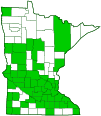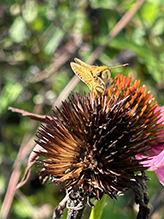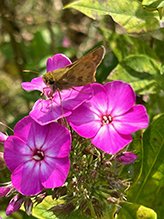Huron sachem
(Atalopedes campestris)
Conservation • Description • Habitat • Ecology • Distribution • Taxonomy
Conservation Status |
|||
| IUCN Red List | not listed |
||
| NatureServe | N5 - Secure SNR - Unranked |
||
| Minnesota | not listed |
||
Description
Huron sachem is a common, medium-sized, late season, migratory skipper. It occurs in the United States from the Great Plains to the East Coast, in the desert southwest, and west of the Rocky Mountains, and in Mexico, Central America, and Columbia. It is one of just a few skippers that migrate north each year. It appears in Minnesota usually in late summer but sometimes as early as late June or early July. It does not survive the winter. It does not appear in the state every year, and it rarely migrates as far as southern Canada. However, evidence suggests that sachem’s range is gradually extending northward as the climate warms.
Huron sachem is found in woodlands, dry grasslands, pastures, parks, gardens, weedy lawns, old fields, power line clearings, railroads, roadsides, and other disturbed areas. Larvae feed on various grasses. In Minnesota, these include crabgrass, Indian goosegrass, and red fescue. In other areas larvae also feed on Bermuda grass and St. Augustine grass. Adults feed on a wide variety of flowers.
Adults have a 1¼″ to 1⅝″ (32 to 42 mm) wingspan. The female is larger than the male.
On the male the upper side of the forewing is yellowish-orange with a broad brown border on the outer margin. Near the middle of the wing there is a large, rectangular patch of black, specialized, scent scales (stigma). As with many skippers, there is also a row of three small pale spots, the “wrist bracelet”, near the leading edge (costal margin) in the subapical area. On the female the base color is variable, from light brownish-yellow to dark yellowish-brown. There is a brown border on the costal margin, a smaller stigma, two large, squarish, glassy spots near the center, and two isolated pale spots near the outer margin.
On the male the upper side of the hindwing is brown with a large, diffuse, orange patch on the inner half crossed by dark veins. On the female the orange patch is more distinct.
The base color of the underside of the hindwing on both sexes is variable, from light brownish-yellow to dark yellowish-brown. On the male it is usually brownish-yellow with yellowish-brown on the outer margin and a yellowish-brown spot on the inner margin near the middle. On the female it is usually yellowish-brown with a distinct, chevron-shaped row of pale rectangular spots.
Size
Wingspan: 1¼″ to 1⅝″ (32 to 45 mm)
Similar Species
Habitat
Woodlands, dry grasslands, old fields, parks, gardens, weedy lawns, roadsides, and other disturbed areas
Ecology
Season
Late June to late September in Minnesota. Usually one generation per year. If it arrives early, there may be a second generation.
Behavior
The caterpillar creates a shelter of rolled leaves tied with silken threads near the base of the grass plant. It leaves the shelter to cut a piece of grass blade, returns with the cutting, and feeds in the shelter.
Life Cycle
The female lays a single, small, white egg on a blade of a host species of grass.
Larva Food/Hosts
Grasses, including crabgrass, Indian goosegrass, and red fescue
Adult Food
Nectar from many flowers
Distribution |
||
|
Sources 21, 24, 29, 30, 71, 75, 82, 83. Biodiversity occurrence data published by: Minnesota Biodiversity Atlas (accessed through the Minnesota Biodiversity Atlas Portal, bellatlas.umn.edu, 10/7/2025). |
|
| 10/7/2025 | ||
Occurrence |
||
Common |
||
Taxonomy
Order
Lepidoptera (Butterflies and Moths)
Superfamily
Papilionoidea (butterflies)
Family
Hesperiidae (skippers)
Subfamily
Hesperiinae (grass skippers)
Tribe
Hesperiini
Subtribe
Hesperiina (branded grass skippers)
Genus
Atalopedes (sachems and allies)
Species
This species was formerly classified as the subspecies Atalopedes campestris huron. A recent genomic analysis of butterflies (Zhang et al., 2022) raised it to full species rank.
Subordinate Taxa
Synonyms
Atalopedes campestris ssp. huron
Atalopedes tenebricosus
Hesperia huron
Common Names
Huron sachem
Glossary
Costal margin
The leading edge of the forewing of insects.
Stigma
In plants, the portion of the female part of the flower that is receptive to pollen. In Lepidoptera, an area of specialized scent scales on the forewing of some skippers, hairstreaks, and moths. In other insects, a thickened, dark, or opaque cell on the leading edge of the wing.
Visitor Photos
Share your photo of this insect.
This button not working for you?
Simply email us at info@MinnesotaSeasons.com.
Attach one or more photos and, if you like, a caption.
Greg Watson |
||
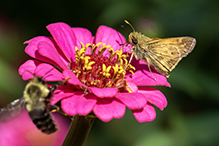 |
||
| I photographed this Huron Sachem, Atalopedes huron, in my backyard in La Crescent yesterday. |
|
|
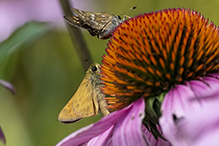 |
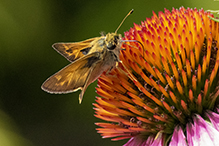 |
|
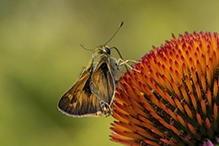 |
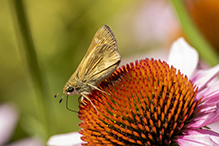 |
|
Lucy Morrissey |
||
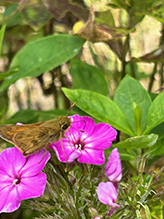 |
||
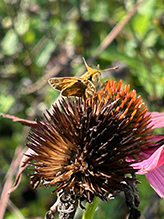 |
||
MinnesotaSeasons.com Photos
|

Slideshows

Visitor Videos
Share your video of this insect.
This button not working for you?
Simply email us at info@MinnesotaSeasons.com.
Attach a video, a YouTube link, or a cloud storage link.
Other Videos
Sachem Skipper (female) enjoying a Zinnia (Atalopedes campestris)
Nature in Motion
Sachem (Atalopedes campestris) Female on Chicory (Cichorium intybus) Get Every Nook and Cranny
Nature's Wild Things
Atalopedes campestris (Female) 08-27-16
wapogipofrog88

Visitor Sightings
Report a sighting of this insect.
This button not working for you?
Simply email us at info@MinnesotaSeasons.com.
Be sure to include a location.
Greg Watson
10/5/2025
Location: La Crescent, MN
I photographed this Huron Sachem, Atalopedes huron, in my backyard in La Crescent yesterday.
MinnesotaSeasons.com Sightings

